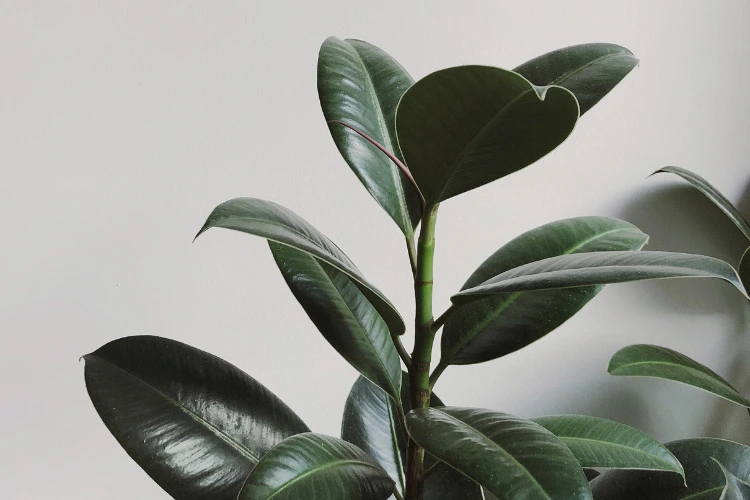
Remarkable Cherry Blossom: The Ultimate Guide To Beautiful Sakura Trees
From the breathtaking blooms to the serene atmosphere, cherry blossom trees offer a unique experience. Embrace the beauty of Sakura trees with us.
Share This Post!
The Sakura tree, also known as the cherry blossom tree, is one of the most recognizable symbols of Japan. These beautiful trees, with their delicate pink or white flowers, bloom each spring, creating a stunning spectacle of natural beauty. But there is much more to the Sakura tree than just its visual appeal.
Flowering cherry trees are different from other cherry trees. The main difference is that they do not bear fruit. Instead, they bloom beautiful pink or white flowers every spring. Sakura trees are the symbols of Japan.
Japan’s national flower, cherry blossom – or Sakura – stands for a moment of renewal and optimism. Thanks to the rapid bloom, cherry blossoms also symbolize life, an essential topic in Buddhism.
While all cherry blossoms have some things in common, there are remarkable differences in their family. You will notice differences in color, shape, size, and more. While most Japanese sakura flowers are pale pink, but they can also be white, dark pink, or even yellow!
Japan has more than 200 Japanese cherry trees, including wild and cultivated species. Here are some of the most common sakura flower varieties in Japan – see if you can spot them in nature.
History Of Sakura Or Cherry Blossoms
The history of the Sakura tree in Japan dates back over a thousand years. The tradition of Hanami, which means “flower viewing,” began during the Heian period (794-1185).
The aristocrats and samurai would gather under the cherry blossom trees to enjoy the fleeting beauty of the blossoms. The tradition of Hanami gradually spread throughout Japan, and today it is an integral part of Japanese culture.
The Sakura tree became a symbol of Japan’s national identity and cultural heritage over time. In the early 20th century, the Sakura tree began to be used as a symbol of the country’s imperial power.
It was during this time that the government began to plant Sakura trees in parks and along streets, promoting the idea that the trees were a symbol of the strength and beauty of Japan.
The meaning of the cherry blossom tree in Japanese culture goes back hundreds of years. In her country, the cherry blossom represents the fragility and beauty of life. Remember that life is almost beautiful but tragically short.
Most wild trees also have many types of cultivated trees, five-petal flowers. However, some species have flowers with ten, twenty, or more petals. “yaezakura” is a tree containing five leaves.
Cherry Blossom Petals
The meaning of the cherry blossom tree in Japanese culture goes back hundreds of years. In Japan the cherry blossom represents the fragility and beauty of life. Remember that life is almost beautiful but tragically short.
Most wild trees also have many types of cultivated trees, five-petal flowers. However, some species have flowers with ten, twenty, or more petals. “yaezakura” is a tree containing five leaves.
Cherry Blossom Symbolism
Cherry blossoms are a symbolic spring flower, a moment of renewal, and the transitory nature of life. Your life is very short.
After her beauty has peaked after about two weeks, the flowers begin to fall off. During this season in Japan, people like to organize cherry blossom parties with their colleagues, friends, and family.
Types Of Japanese Cherry Blossom Tree
Cherry Blossom trees produce stunning displays of pink and white blossoms in the spring, and their beauty has inspired countless artists and poets throughout history.
Whether you prefer the delicate pink blossoms of the Somei Yoshino or the vibrant pink of the Kanzan, there is a cherry blossom tree out there that is sure to capture your heart.
1. Yoshino Cherry Tree
Cherry Blossom trees produce stunning displays of pink and white blossoms in the spring, and their beauty has inspired countless artists and poets throughout history.
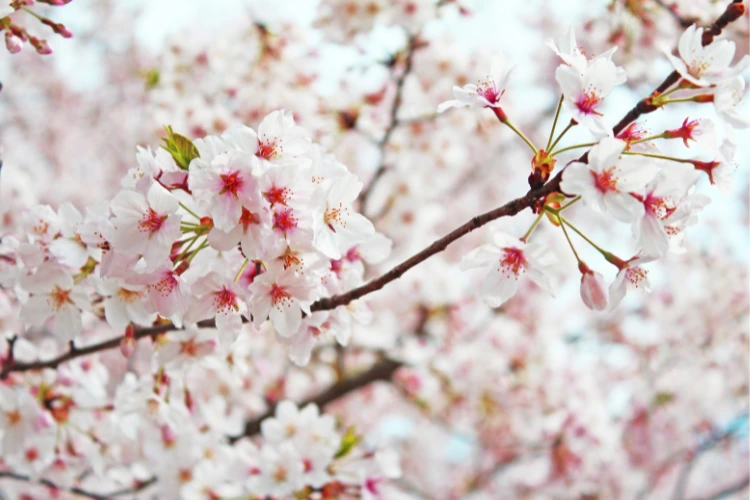 Whether you prefer the delicate pink blossoms of the Somei Yoshino or the vibrant pink of the Kanzan, there is a cherry blossom tree out there that is sure to capture your heart.
Whether you prefer the delicate pink blossoms of the Somei Yoshino or the vibrant pink of the Kanzan, there is a cherry blossom tree out there that is sure to capture your heart.
2. Okame Cherry Tree
This tree was originally grown from a Prunus cross and Prunus campanulata carved in England. A breeder named as captain “Collingwood Ingram” tried to create a tree with bright pink flowers, but the parent plants had no low tolerance to cold.

“Collingwood Ingram“
He is the British ornithologist, plant collector, and gardener, who was an authority on Japanese flowering cherries.
It grows in a vase-like structure before it ripens before it rolls with age. Stunning pink and white flowers add beauty to the landscape and can be planted in any season. Okame produces candyfloss-pink flowers in spring and is ideal for cherry trees or small gardens.
If it doesn’t bloom, the green is still beautiful. It remains intensely green until the end of August, and then it begins to turn yellow before turning into a dense orange and red.
3. Kanzan Sakura
The Somei Yoshino cherry blossom tree is the most common and well-known variety of cherry blossom in Japan.
It is a hybrid of two other cherry blossom varieties and produces delicate, pale pink blossoms that are tinged with white.
The Somei Yoshino is a fast-growing tree and can reach heights of up to 35 feet. It blooms in late March or early April, and its blossoms usually last for about two weeks.
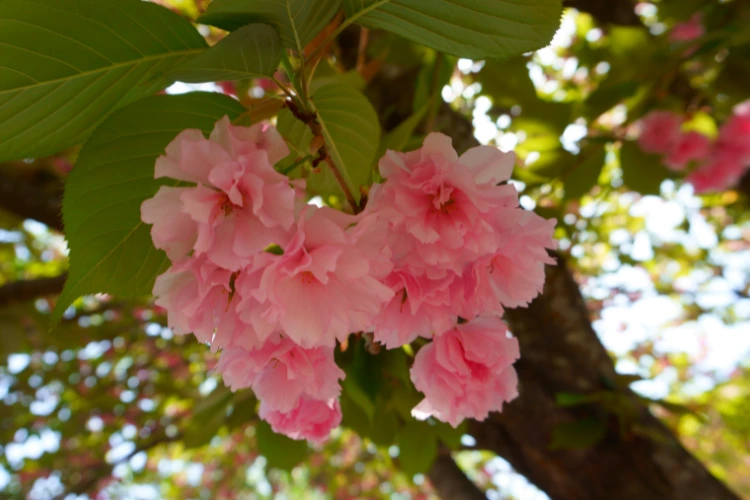
The Kanzan typically blooms in mid-April and produces double-petaled blossoms that create a dense, fluffy look.
The Kanzan cherry blossom tree is known for its vibrant, deep pink blossoms. This tree is a popular ornamental tree in many parts of the world and can be found in parks, gardens, and along streets.
5. Fugenzo
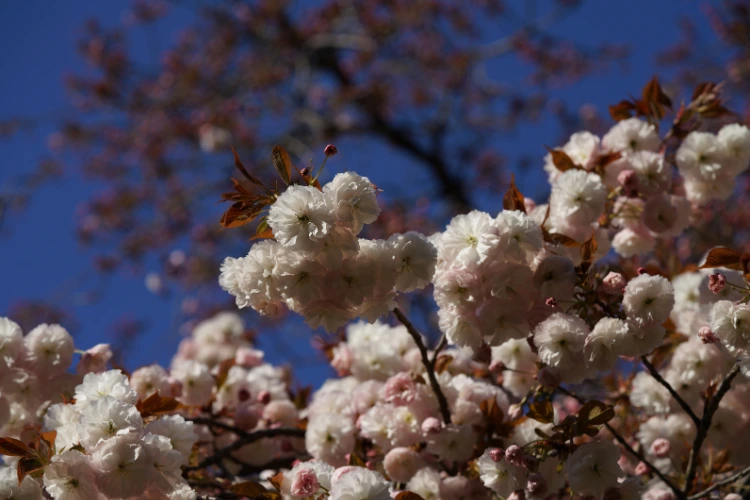 The Fugenzo cherry blossom tree is a popular choice for gardeners who want to create a unique and eye-catching display.
The Fugenzo cherry blossom tree is a popular choice for gardeners who want to create a unique and eye-catching display.6. Yaezakura
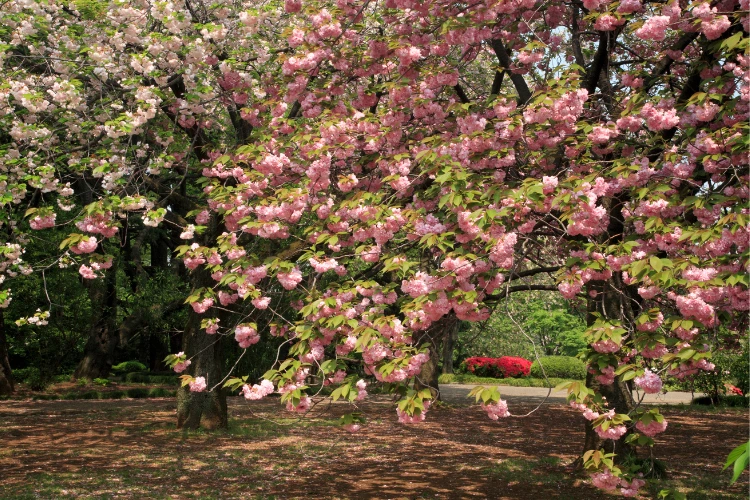
Yaezakura’s blossoms are larger and fuller than those of other cherry blossom trees, and they often have a frilly, fluffy appearance.
The Yaezakura cherry blossom tree is a double-petaled variety that produces pink or white blossoms.
Yaezakura typically blooms in mid-April and its blossoms can last for up to two weeks.
Some More Information
| Cherry Blossom Tree Scientific Name | Prunus x incamp ‘Okame’ |
|---|---|
| Sakura Tree Latin Name |
|
| Origin | China, Japan, & England |
| Foliage |
|
| Height & Spread |
|
| Sun Soil Water | Full Sun Moist & Well Drained Medium Water |
| Pests & Diseases | Rot, Blight, Mildew, Aphids, Scale |
Amazing Facts About Sakura Or Cherry Blossom Tree
The cherry blossom is the national flower of Japan. It is deeply ingrained in the culture and is celebrated each year during the annual cherry blossom festival.
Cherry blossom trees are not native to Japan. They were first brought to the country from China around the 7th century AD.
Cherry blossom season is a big deal in Japan. People from all over the country flock to parks and gardens to see the cherry blossoms in full bloom. This tradition is known as Hanami, which means “flower viewing.”
Cherry blossoms are not just pink. There are actually several different varieties of cherry blossom trees, each with its own unique color, including white, yellow, and even green.
Cherry blossom season is notoriously difficult to predict. The exact timing of the blooming season can vary from year to year depending on weather conditions, and predictions are often inaccurate.
Cherry blossoms only bloom for a short period of time. Typically, the flowers are in bloom for just a few weeks each spring.
The cherry blossom has a special significance in Japanese culture. It represents the beauty and transience of life, as well as the impermanence of things.
Cherry blossom trees have been given as gifts between countries as a symbol of friendship. In 1912, Japan gifted 3,000 cherry blossom trees to the United States as a symbol of goodwill, and these trees still bloom in Washington D.C. each spring.
The cherry blossom has inspired many artists and poets throughout history. The flowers are a popular subject in traditional Japanese art, and they have also been featured in numerous works of literature.
In Japan, cherry blossom season is also a time for picnics and parties. People gather under the blooming trees to eat, drink, and celebrate the arrival of spring.
These interesting facts demonstrate the significance and beauty of cherry blossoms, which continue to captivate people all over the world.
